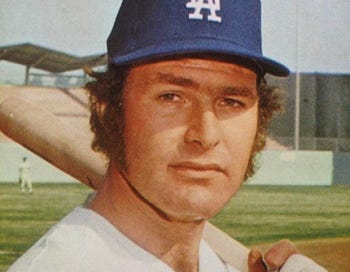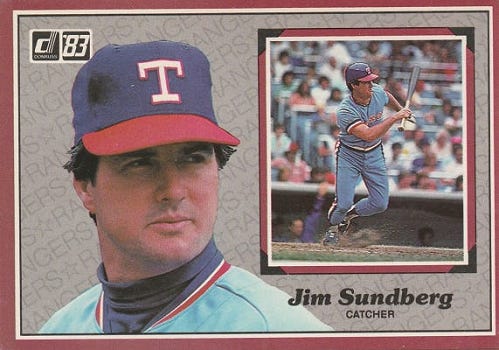Note: When you click on links to various merchants in this newsletter and make a purchase, this can result in this newsletter earning a commission. Affiliate programs and affiliations include, but are not limited to, the eBay Partner Network and Amazon Associates.
1971 Ticketron Duke Sims - Card of the Day
(affiliate link)
Duke Sims didn’t wear Dodger blue for long, but it was long enough to make a splash in an oddball set that packs a heavy nostalgia punch. But before we get to how a boy from Pocatello ended up discoing with Ticketron on the hobby dance floor…
Sims originally signed as an amateur free agent with the Cleveland Indians in 1959 and then spent the next six seasons climbing their minor league ladder. By the time he made his big league debut on September 22, 1964, the left-handed-hitting catcher had shown himself a capable handler of pitchers.
He was also a pretty good bet for a batting average around .270 or better, plus double-digit-homer power. So, even after going hitless in his two-game cup-of-coffee to end the season, Sims was back with the Tribe by June of 1965 following a hot start at Triple-A Portland.
And this time, Sims stuck in Cleveland, aside from a few games back on the farm in 1966. with the Tribe, Sims served mostly as a backup for starting backstop Joe Azcue, with some pinch-hitting appearances mixed in here and there. But the youngster’s playing time increased over time, as did his versatility, and he logged time at first base and in the outfield corners in 1968.
Then, on April 19, 1969, the Indians traded Azcue, Vicente Romo, and Sonny Siebert to the Red Sox for Dick Ellsworth, Ken Harrelson, and Juan Pizarro.
Just a few games into the new season, 27-year-old Duke Sims was the Indians’ primary catcher…and placeholder, as it turned out.
After hitting .236 with 18 home runs and 45 RBI in 1969, Sims was back to position-hopping in 1970. With sophomore Ray Fosse taking over behind the plate most nights, Sims again split his time between catching, first base, the outfield corners, and pinch hitting.
Even with his duties divided, though, Sims made the most of his plate appearances, hitting .264 with 23 home runs and 56 RBI, all career highs to that point.
But then in December of 1970, the Tribe traded Sims to the Dodgers in exchange for Alan Foster and Ray Lamb. That was at least sorta good news for Sims, as Tom Haller, the man who took over behind the plate after L.A. traded John Roseboro to the Twins in 1967, was entering his age-34 season.
And if there’s a Duke in baseball, doesn’t he belong with the Dodgers at some point? Even if the team no longer has an outright claim on Flatbush?
As things played out, Sims did indeed grab a lot of squat time in 1971, appearing in 74 games at catcher, to Haller’s 66. The real problem for both players, in the long term at least, was that young Joe Ferguson was just getting warmed up in the majors.
Even worse, the even-younger Steve Yeager was just about finished with his own minor league climb. Once he made it to Dodger Stadium for good, catcher was pretty much a part-time gig for any other L.A. backstop hopefuls.
But all that lay in the future as Sims and Haller and the Dodgers went about trying to win a division title in 1971. They’d finish a close second to the Giants…and they’d look pretty darn good doing it.
If there was ever any doubt about that, Ticketron laid it to rest with a 20-card set featuring the 1971 Dodgers. Each card was big (4" x 6"), bold, and clean, with no design elements except for a facsimile player autograph.
Card backs were busy but jam-packed with information, including a full home schedule:
(affiliate link)
There was a crystal-ball element to these cards, too, as Ticketron also issued a ten-card set featuring the Giants.
Did that big computer running Ticketron’s ticket-sales machine have some insight into the National League West race? Maybe, but they also issued a set featuring the last-place Phillies (N.L. East) in 1972. So maybe the tea leaves were stale by then.
Whatever the case, Ticketron gave L.A. fans their first cardboard look at Sims in Dodger Blue, and just in the nick of time. Because, after a slow first half in 1972 that saw him hit .192 in his 51 games, the Dodgers waived Sims.
The Tigers claimed him in August, and from there, it was a ping-pong bounce down the drain hole for his big league career. Through the end of 1974, he’d log time for Detroit, the Yankees, and the Rangers (who traded Larry Gura to get him), never really (ahem) catching on with any of them.
Sims did rack up a couple of notables along the way to his last major league game (September 26, 1974), though.
On September 30, 1973, Sims hit the last home run at old Yankee Stadium, before the 1974-75 renovation. He also caught all nine innings in that one, teaming up with battery mates Fritz Peterson, Lindy McDaniel, and Wayne Grange, in an 8-5 loss to Detroit…the team that had waived him about a week earlier.
And, on July 30, 1974 — exactly ten months later — Sims connected on his last career home run…which was also his 100th career home run.
Today, century man Duane B. Sims turns 84 years old.
Cardboard Proof Jim Sundberg Was a Star
Sims’ last home run came as a pinch hitter, replacing Rangers starting catcher Jim Sundberg in the bottom of the ninth in a blowout loss to the A’s. Sundberg was in the middle of a rookie season that established him as a star, even if no one talks about him like that today.
Nine years later, Sundberg was still playing. And, even though his most productive summers were behind him, a big, bold Donruss Action All-Star card was there to great young collectors and make sure we know at least a little about his place in the game.
Read all about it right here.
By the way…
Sundberg also got to experience, firsthand, the “Seasons in Hell” Rangers of Billy Martin, as chronicled by Mike Shropshire. If you’re in the mood for a gritty, unvarnished, but funny account of big league baseball in the 1970s — from the inside — this should do the trick.
(affiliate link)







